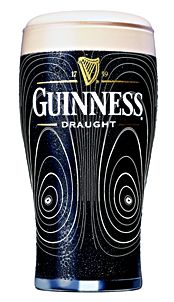Technology Settles Longstanding Debate: Do Bubbles in a Glass of Guinness Go Down?
Simulation Software Proves Once and For All,
Bubbles Go Up…And Down!

December 21, 1999, Lebanon, New Hampshire – Computer simulation has settled a long-standing mystery haunting pubs and perplexed beer drinkers for centuries. Why do the bubbles in a glass of Guinness beer go down instead of up? Despite the common knowledge that bubbles float up, beer drinkers over the ages have argued, even after an evening of studying the issue, that a large portion of the bubbles actually move downwards.
Professor Clive Fletcher and his students at the University of New South Wales, Sydney, Australia, have used the latest industrial simulation methods to solve this mystery. The research team simulated the motion of the bubbles using FLUENT computational fluid dynamics (CFD) software from Fluent Incorporated (www.fluent.com) to attack the problem head-on, so to speak. CFD simulations allow engineers to graphically depict fluid flows, pressure, temperature, and chemical concentration at any location, making it possible to quickly gain a better understanding of any problem involving fluid flow.
Fletcher’s team used this software to simulate the motion of the bubbles and discovered that, as expected, most bubbles do move upwards. The bubbles in the center of the glass, free from the effects of the wall, move upwards most quickly and drag liquid with them. But the liquid moving up in the center of the glass, having nowhere else to go, must eventually turn towards the walls and start to move downward. The liquid moving downward near the walls tries to drag down bubbles with it. Larger bubbles have sufficient buoyancy to resist but smaller bubbles (less than 0.05 mm) are continuously dragged to the bottom of the glass.
These results can be clearly seen in animation of the simulation results that is available at www.fluent.com/news/pressrel/guinness/tsld001.htm. The animation, which is based on the actual physics, clearly shows the bubbles moving downwards around the edges of the glass. Of course, the primary use of FLUENT CFD software is solving far more serious fluid flow problems, optimizing vehicle aerodynamics, speeding up the mixing process in chemical reactors and improving the performance of ventilation fans, for example. From answering the perplexing Guinness riddle to helping design the escape vehicle for the International Space Station (NASA), CFD software is making it possible to gain a much better understanding of our environment.
Company Background
Fluent Inc. is a wholly-owned subsidiary of Aavid Thermal Technologies Inc. (Nasdaq:AATT). Fluent is a world leader in the rapidly growing field of computerized design and simulation software. Fluent's software is used to predict fluid flow, heat and mass transfer, chemical reaction and related phenomena. Fluent's software products and services help engineers in leading corporations worldwide with detailed product development, design optimization, trouble shooting, scale-up and retrofitting. Fluent's software significantly reduces engineering cost, while improving the final design of products in applications ranging from design of electronic components and systems to automotive engineering, and from combustion system design to process plant troubleshooting. Fluent's corporate headquarters are located in Lebanon, New Hampshire, USA. Fluent's European headquarters are located in Sheffield, England, with local offices in France, Germany, and Italy. Fluent's CFD software is also available around the world through joint ventures, partnerships and distributors in Japan, Korea, Australia, the Czech Republic, and most European countries.
Additional information on Fluent's products can be obtained on the World Wide Web at http://www.fluent.com or by e-mailing [email protected]. More information on Aavid Thermal Technologies is available at http://www.aavid.com. FLUENT, FIDAP, POLYFLOW, MixSim and Icepak are trademarks of Fluent Inc.
